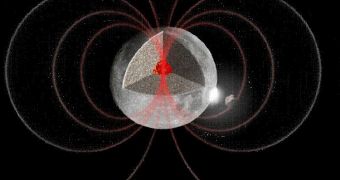Previous studies of the Moon have concluded that it once had a magnetic field, a discovery that threw scientists completely off-balance. Now, two research team provide separate explanations for this phenomenon, and their theories are not necessarily mutually-exclusive.
In fact, it may be that their explanations are complementary, although more studies are needed to assess whether that is indeed the case. Scientists are now planning to return to work in analyzing both these possibilities, in hopes of somehow disproving or reconciling them.
The entire mystery began when the Apollo missions returning rock samples from the Moon brought back material that displayed signs of magnetism. This involves the presence of a north and south magnetic poles, as well as a small, yet discernible magnetic field.
According to geologists, magnetic rocks can develop when molten lava solidifies in the presence of a magnetic field, while incorporating certain types of minerals. How this may have happened on the Moon remained a hotly-debated topic since the 1960s.
On Earth, a magnetic field is caused by the dynamo motion of liquid iron within the outer core of the planet. This type of movement is caused by a phenomenon called convection of heat, which requires a lot of space to have discernible effects. Such larges space are not available on the Moon.
A University of California in Santa Cruz (UCSC) team led by Christina Dwyer now proposes that the liquid iron core the Moon may still retain is in fact stirred up by the satellite's mantle, the layer that connects the surface to the core.
If the core and mantle rotate around slightly-different axes, then such a scenario is entirely possible, the team argues. Another condition that would have to be met is that the boundary between the mantle and the core is not exactly spherical. In this case, the irregularities would mix the liquid iron.
In the past, tidal forces acting from our planet to the Moon were a lot stronger than they are today. They may have played a role in keeping the core-mantle angle slightly skewed, but this difference may have subsided in time. This could help explain why the Moon no longer has a magnetic field
“Based on what we know about stirring, and everything we know about fluid motion, we can find no reason that this would not work. All the flags are go, and now this needs to be taken to the next level to get tested,” Dwyer and her team say in the November 10 issue of the top scientific journal Nature.
Another potential explanation comes from Michael Le Bars, who holds appointments with both the French National Center for Scientific Research and the Université Aix-Marseille. He and his team believe that cosmic impacts may have also played a role in stirring up the Moon's core.
The team recognizes that the mantle may have stirred the core, but say that tidal influences from Earth had a much smaller influence that asteroids and meteorites striking the satellite from space had.
“The two studies are thought-provoking and may be complementary. Future palaeomagnetic experiments on samples from very old lunar rocks will enable their theories to be tested,” explains Dominique Jault, as quoted by Space.
The expert, who was not a part of the investigation, is based at ETH Zürich, in Switzerland. Jault published his comments in the same issue of Nature that contained both studies.

 14 DAY TRIAL //
14 DAY TRIAL //